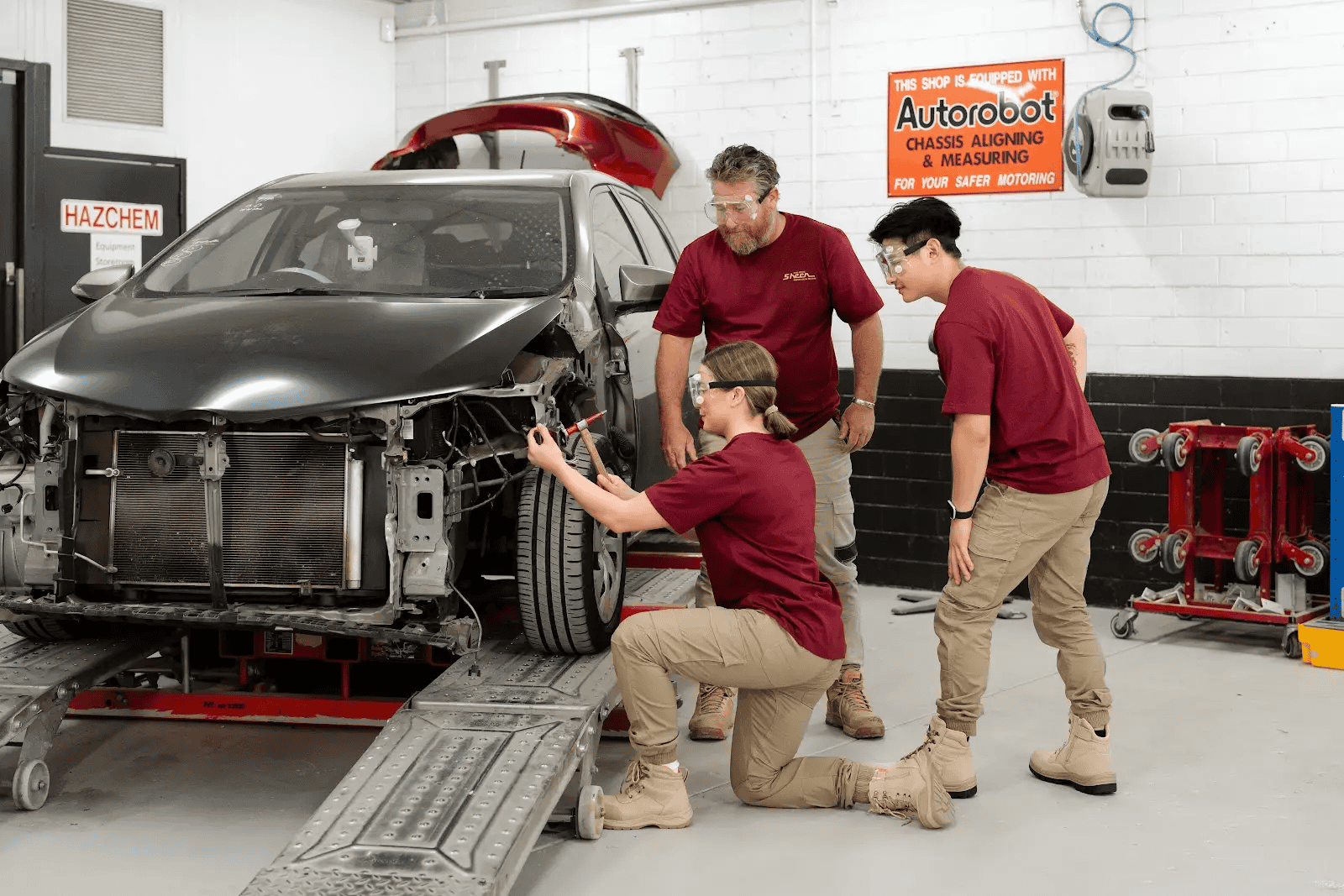Sheen Resources


Accidents on the road are a fact of life. If you've never been in a collision, you probably aren't familiar with the process behind how car insurance works in an accident.
What to know before you make a car insurance claim
If you’ve been involved in a car accident in Melbourne, you may be wondering how to make a car insurance claim and, just as critically, how to make sure it’s handled properly. The process can seem overwhelming, especially if it’s your first time. But with the right preparation and support, you can get through it smoothly and get your vehicle back on the road.
At Sheen Panel Service, we’ve been helping Australian drivers with insurance after motor vehicle accident claims for over 50 years. We work with all major insurance providers and know how to navigate the process to minimise stress, delays, and confusion. This guide is based on our real experience, not just generic info, so you can feel confident about what comes next.
Here’s what we’ll cover:
- What to do at the scene of a car accident
- When to make a claim (and when not to)
- How to lodge a claim with your insurer
- How long after an accident you can lodge an insurance claim
- What happens after your claim is submitted
- Special advice if you’re not at fault
- How Sheen can support you every step of the way
Let’s walk through the process together.
This guide will help you navigate the claim process with clarity, from the moment your motor vehicle is damaged to when it’s fully repaired and back on the road.

How does insurance work in a car accident?
Understanding your obligations under Australian car insurance law is essential, especially when it comes to issues like the ‘duty of disclosure’, property damage, or injury claims. These obligations can influence how your insurer responds to your claim and whether they’ll accept or deny it.
When you’re involved in a car accident, your insurance policy is designed to help cover the financial fallout, but exactly how that works depends on a few key factors. In general, if the accident is covered by your policy, your insurer will either pay for the cost of repairs or replace your vehicle (depending on the level of damage), minus any applicable excess.
If you're not at fault and the other driver is insured, your insurer will usually recover costs from their provider. If you're at fault, your insurance policy covers the damage you've caused to your own car, the other party’s vehicle, or public property, depending on your level of cover.
Your insurance company may arrange towing, assess damage through an approved repairer, and manage the claim from start to finish. But you don’t have to do it alone. We assist customers throughout this process, including claims related to damage to your vehicle or transport accidents. We’ll help you deal with paperwork, inspections, and repair coordination so that everything runs smoothly.
Learn more about car insurance below:
What to do straight after a car accident
If you’ve been in an accident, staying calm and acting quickly can help reduce further risk and support a smooth claim. Here are the essential steps:
- Make sure everyone is safe and out of harm’s way. If there are people who are injured or vehicles blocking the road, call emergency services immediately.
- Turn on your hazard lights to alert other drivers and help prevent a secondary road accident.
- Exchange contact details, vehicle registration, and insurance details with the other driver(s)
- Take clear photos of all vehicle damage, license plates, and the location
- Write down what happened while it's fresh in your memory, including the type of car accident and whether any property damage occurred. Focus on details: where were you on the road, what were you doing, what happened right after…
- Report the accident to the police if required (especially if someone is injured, the other party refuses to exchange details, or a crime has occurred)
Even if it's a minor accident, documenting the incident clearly will support your case when dealing with insurance. You’ll need this information when you begin your car insurance claim, including when lodging a claim under third-party insurance or other comprehensive car insurance policies.
[nearest_workshop][/nearest_workshop]
Should you make an insurance claim?
Just because you’ve had an accident doesn’t mean you’re required to make a claim. In some cases, claiming might cost you more in the long run, especially if the accident was your fault or the repair cost is minor. It’s important to weigh the short-term costs, like needing to pay an excess or an increased insurance premium, against the long-term protection a claim provides.
Here are a few key things to weigh up before deciding:
- Is the damage covered by your policy? Review your relevant Product Disclosure Statement (PDS) for any exclusions or limitations.
- What’s your excess? If the total repair bill is less than or just above your excess, it might make more sense to pay out of pocket.
- Are you at fault? A successful claim might still impact your premium or affect your no-claim bonus.
- Is the other party insured and cooperative? This could affect how costs are recovered and how long your claim takes to settle.
- Have you had multiple claims recently? Too many claims can raise red flags with your insurer and potentially lead to higher premiums or reduced coverage.
Understanding whether to make a claim also means knowing your responsibilities, including your duty of disclosure and who may be liable for any loss or damage. Insurers will assess the situation carefully to determine who was at fault and assign responsibility for any loss.
Making a claim is often the right move, especially for serious damage to your vehicle, accident injuries, or transport accidents involving uninsured drivers, so it’s always worth getting advice before you commit. Our team at Sheen can guide you through your options and help you make the best choice for your situation.
How to lodge a claim with your insurer in 3 steps
Once you’ve decided to make a claim, the next step is to lodge it with your insurance provider. Here’s how the process typically works:
1. Gather your evidence
You’ll need several key documents to support your claim. These include:
- Your insurance policy number
- Photos of the damage to your vehicle and the scene of the accident
- Contact and insurance details of the other driver(s) involved in the accident
- A police report number (if one was filed)
2. Lodge your claim
Most insurers allow you to claim online, via an app (such as RACV), or over the phone. Be prepared to describe the type of car accident and how the accident happened, and submit your supporting documents. If you already have an existing claim, make sure to refer to your reference number when following up.
3. Choose your repairer
You’re not obligated to use the insurer’s preferred repairer. At Sheen, we offer authorised repairs that meet or exceed industry standards. We can also assist with claim paperwork and coordination to make the process faster and easier.

How long after an accident can you claim car insurance?
If you’ve been in an accident in Victoria (or anywhere in Australia), it’s best to lodge your car insurance claim as soon as possible. Most insurers recommend starting the process within days of the incident. However, the timeframe can depend on your policy and whether a delay could impact their ability to assess the situation accurately.
Some policies set hard limits (e.g. 30 days), while others allow more flexibility. To protect your rights, always refer to your insurer’s Product Disclosure Statement or contact them directly. You should also notify the police about the accident — this is often essential for lodging an accident injury claim or making a TAC claim.
If in doubt, call us, and we’ll help you understand the need for your insurance claim and support you through next steps.
What happens after your claim is submitted?
Once your claim is lodged, your insurer will begin assessing it. Here’s what to expect:
- You’ll receive confirmation and a reference number (if submitted online or via app)
- Your insurer will evaluate the details of the accident, damage to your car, and supporting documents
- They’ll determine who was at fault and whether your claim will be approved
- You may need to pay the excess before repairs begin, depending on your policy
- If approved, they will coordinate repairs, replacement vehicles, and payment to the repairer
If your claim is delayed, denied, or requires further action, your insurer should notify you in writing. The General Insurance Code of Practice sets guidelines for how long this should take: typically no more than 10 business days.
What if you’re not at fault?
If the accident wasn’t your fault, your insurer will generally seek reimbursement from the at-fault driver’s provider. This means you may be eligible for a waiver of your excess and faster repairs. But what happens if the other driver is uninsured or denies responsibility?
This is where Sheen makes a difference. We can help:
- Document the scene thoroughly to support your position
- Contact your insurer and liaise with them on your behalf
- Assist with replacement vehicles while your car is in for repair
- Guide you through additional steps, like lodging through the Transport Accident Commission if injuries are involved
How Sheen can support you every step of the way
With over 50 years’ experience handling car insurance claims across Australia, Sheen Panel Service provides more than just smash repairs. We’re your partner through every stage of the claim process.
Here’s how we help:
- Towing and accident recovery if your car can’t be driven
- Accident replacement vehicles to keep you mobile
- Help with insurer paperwork and lodging claims
- Authorised smash repairs using manufacturer-approved techniques and parts
When you need advice, support, or a repairer you can trust, contact Sheen.
[upload_smash][/upload_smash]

.png)




















